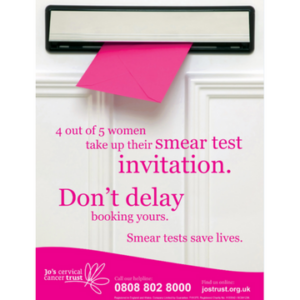Queen Square Surgery are currently taking part in a research study looking at the accuracy of urine HPV testing for cervical screening. If you are interested in learning more about this or taking part, please follow this link to our research page ACES – Queen Square Medical Practice
What is cervical screening?
Cervical screening (a smear test) checks the health of your cervix. The cervix is the opening to your womb from your vagina.
It’s not a test for cancer, it’s a test to help prevent cancer.
All women and people with a cervix aged 25 to 64 should be invited by letter. During the screening appointment, a small sample of cells will be taken from your cervix.
Why it’s important
Cervical screening is one of the best ways to protect yourself from cervical cancer. Cervical screening is not a test for cancer, it’s a test to help prevent cancer.
How cervical screening helps prevent cancer
Cervical screening checks a sample of cells from your cervix for certain types of human papillomavirus (HPV). These types of HPV can cause abnormal changes to the cells in your cervix and are called “high risk” types of HPV. If these types of HPV are not found, you do not need any further tests. If these types of HPV are found, the sample is then checked for any changes in the cells of your cervix. These can then be treated before they get a chance to turn into cervical cancer. If abnormal cells are not treated, they may turn into cervical cancer.
You’ll get your results by letter, usually in about 4 weeks. It will explain what happens next.
What is HPV?
HPV is the name for a very common group of viruses. Most people will get some type of HPV during their lives. It is very common and nothing to feel ashamed or embarrassed about. You can get HPV from any kind of skin-to-skin contact of the genital area, not just from penetrative sex.
Some types of HPV (called “high risk” types) can cause cervical cancer. In most cases your body will get rid of HPV without it causing any problems. But sometimes HPV can stay in your body for a long time.
If high risk types of HPV stay in your body, they can cause changes to the cells in your cervix. These changes may become cervical cancer if not treated.
If you do not have a high risk type of HPV it is very unlikely you will get cervical cancer, even if you have had abnormal cell changes in your cervix before.
Finding high risk HPV early means you can be monitored for abnormal cell changes. Abnormal changes can be treated so they do not get a chance to turn into cervical cancer.
Who’s at risk of cervical cancer
If you have a cervix and have had any kind of sexual contact, with a man or a woman, you could get cervical cancer. This is because nearly all cervical cancers are caused by infection with high risk types of HPV.
You can get HPV through:
- vaginal, oral or anal sex
- any skin-to-skin contact of the genital area
- sharing sex toys
You’re still at risk of cervical cancer if:
- you have had the HPV vaccine – it does not protect you from all types of HPV, so you’re still at risk of cervical cancer
- you have only had 1 sexual partner – you can get HPV the first time you’re sexually active
- you have had the same partner, or not had sex, for a long time – you can have HPV for a long time without knowing it
- you’re a lesbian or bisexual – you’re at risk if you have had any sexual contact
- you’re a trans man with a cervix
- you have had a partial hysterectomy that did not remove all of your cervix
If you’ve never had any kind of sexual contact with a man or woman, you may decide not to go for cervical screening when you are invited. But you can still have a test if you want one.
If you’re not sure whether to have cervical screening, talk to your GP or nurse.
Cervical screening is a choice. It’s your choice if you want to go for cervical screening. But cervical screening is one of the best ways to protect you from cervical cancer.
Risks of cervical screening
You may have some light bleeding or spotting after cervical screening. This should stop within a few hours.
If abnormal cells are found and you need treatment, there are some risks, such as:
- treating cells that may have gone back to normal on their own
- bleeding or an infection
- you may be more likely to have a baby early if you get pregnant in the future – but this is rare.
For more information, read the leaflet: NHS cervical screening – Helping you decide
When you’ll be invited
All women and people with a cervix between the ages of 25 and 64 should go for regular cervical screening. You’ll get a letter in the post inviting you to make an appointment.
When you’ll be invited for cervical screening
| Chart showing age range and when you’ll be invited for screening | |
| Age | When you’re invited |
| under 25 | up to 6 months before you turn 25 |
| 25 to 49 | every 3 years |
| 50 to 64 | every 5 years |
| 65 or older | only if 1 of your last 3 tests was abnormal |
You can book an appointment as soon as you get a letter.
If you missed your last cervical screening, you do not need to wait for a letter to book an appointment.
When cervical screening is not recommended
- If you’re under 25
You will not be invited for cervical screening until you’re 25 because:
- cervical cancer is very rare in people under 25
- it might lead to having treatment you do not need – abnormal cell changes often go back to normal in younger women
- If you’re 65 or older
- You’ll usually stop being invited for screening once you turn 65. This is because it’s very unlikely that you’ll get cervical cancer.
You’ll only be invited again if 1 of your last 3 tests was abnormal.
If you’re 65 or older and have never been for cervical screening or have not had cervical screening since the age of 50, you can ask your GP for a test.
- If you have had a total hysterectomy
You will not need to go for cervical screening if you have had a total hysterectomy to remove all of your womb and cervix. You should not receive any more screening invitation letters.
How to book
You’ll be sent an invitation letter in the post when it’s time to book your cervical screening appointment.
Most cervical screening is done in a GP surgery by a female nurse.
Call the surgery on 01524 843333 to book an appointment. You might be able to book the appointment online. We usually run a smear clinic the 2nd Saturday of the month in addition to the week day clinics.
When to book cervical screening
Try to book your appointment as soon as you get invited. If you missed your last cervical screening, you do not need to wait for a letter.
It’s best to book an appointment for a time when:
- you’re not having a period – also try to avoid the 2 days before or after you bleed (if you do not have periods, you can book any time)
- you have finished treatment if you have unusual vaginal discharge or a pelvic infection.
- At least 3 calendar months after giving birth or after a termination of pregnancy or gynaecological procedure.
- If you are advised to attend for a test after a colposcopy procedure, for example “6 months after procedure”, please attend for smear at least 6 calendar months after your procedure or your sample will be rejected by the laboratories.
What happens at your appointment
During cervical screening a small sample of cells is taken from your cervix for testing.
The test itself should take less than 5 minutes. The whole appointment should take about 10 minutes.
It’s usually done by a female nurse.
Before starting, they should explain what will happen during the test and answer any questions you have.
See what the cervix is:
See what a speculum and brush may look like
How cervical screening is done
You’ll need to undress, behind a screen, from the waist down. You’ll be given a sheet to put over you.
The nurse will ask you to lie back on a bed, usually with your legs bent, feet together and knees apart. Sometimes you may need to change position during the test.
They’ll gently put a smooth, tube-shaped tool (a speculum) into your vagina. A small amount of lubricant may be used.
The nurse will open the speculum so they can see your cervix.
Using a soft brush, they’ll take a small sample of cells from your cervix.
The nurse will close and remove the speculum and leave you to get dressed.
Your results
Your cervical screening results are usually sent to you in a letter. Sometimes you may be asked to call us to get the results.
The nurse who does your cervical screening will tell you when you can expect your results letter.
If you have waited longer than you expected, call the surgery to see if they have any updates.
Try not to worry if it is taking a long time to get your results letter.
It does not mean anything is wrong, and most people will have a normal result.
What your results mean
Your results letter will explain what was tested for and what your results mean.
Sometimes you’ll be asked to come back in 3 months to have the test again. This does not mean there’s anything wrong, it’s because the results were unclear. This is sometimes called an inadequate result.
There are 2 different kinds of HPV positive result:
Human papillomavirus (HPV) is not found in your sample
Most people will not have HPV (an HPV negative result).
This means your risk of getting cervical cancer is very low. You do not need any further tests to check for abnormal cervical cells, even if you have had these in the past.
You’ll be invited for screening again in 3 or 5 years.
HPV is found in your sample
Your results letter will explain what will happen next if HPV is found in your sample (an HPV positive result).
You may need:
- another cervical screening test in 1 year
- a different test to look at your cervix (a colposcopy)
HPV is a common virus and most people will get it at some point. You can get it through any kind of sexual contact.
Having a positive HPV result does not mean your partner has had sex with someone else while you have been together.
You might have HPV even if you have not been sexually active or not had a new partner for many years.
If you need a colposcopy
A colposcopy is a simple procedure to look at your cervix.
It’s similar to having cervical screening, but it’s done in hospital.
You might need a colposcopy if your results show changes to the cells of your cervix.
Find out more about having a colposcopy
Try not to worry if you have been referred for a colposcopy.
Any changes to your cells will not get worse while you’re waiting for your appointment.
Further information:
Call the surgery if you have questions about cervical screening invitations, results or any symptoms you have. You may need more help and support with cervical screening for many reasons. More information is available on the NHS website or Jo’s Cervical Cancer Trust.
Further help and support for cervical screening – NHS – NHS (www.nhs.uk)
Click here to access their Easy Read booklet: Having a smear test. What is it about?
Opting out of the Cervical Screening Programme
If you do not wish to have a cervical smear, you can opt out for up to 18 months at any one time. To do this you will need to write to us at the practice.




